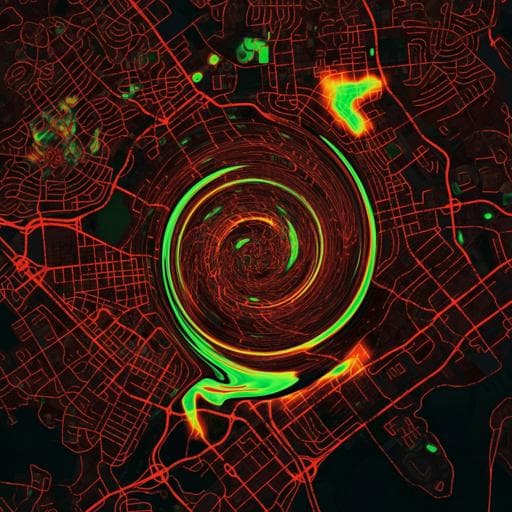
Environmental Studies and Forestry
Surface warming in global cities is substantially more rapid than in rural background areas
Z. Liu, W. Zhan, et al.
This exciting study reveals that urban areas are warming at a rate of 0.50 ± 0.20 K per decade, significantly faster than rural regions. Conducted by Zihan Liu, Wenfeng Zhan, Benjamin Bechtel, and others, it highlights the key roles of climate change and urban expansion in driving this trend, particularly in China and India, while showing how urban greening can help mitigate warming effects in Europe.
~3 min • Beginner • English
Introduction
Urban residents face amplified heat exposure due to the urban heat island effect, which is expected to intensify with global warming and urban growth. Many assessments still rely on non-urban station data and often assume equal warming rates in urban and rural areas. Prior studies have attempted to separate urbanization signals from temperature records, largely focusing on regional effects and often using stations located on urban fringes with potential inhomogeneities. Other work compared urban and rural observations or reanalysis data, but in-situ urban–rural station pairs are scarce and satellite-based land surface temperature (LST) studies frequently conflate urban-core warming with changes due to land conversion. The research question here is whether and by how much surface warming trends within urban cores differ from rural background trends globally, and what contributions background climate change, urbanization, and landscape greening make to those trends.
Literature Review
Earlier studies isolating urbanization effects from surface air temperature (SAT) have shown substantial urbanization-induced regional warming, particularly in rapidly urbanizing China, but often relied on stations affected by siting and instrument changes and located at urban fringes. Studies using SAT- or LST-based urban–rural differences reported positive but variable surface UHI intensity trends, with limitations due to sparse urban stations and lack of separation between stable urban cores and transitional (newly urbanized) pixels. Global LST-based analyses reported daytime UHI trends around 0.29 K/decade and small or near-zero nighttime trends, but their treatment of transitional land likely biased estimates. There is also evidence that city size and population relate to UHI magnitude, and that vegetation changes influence urban thermal environments. This study builds on and addresses gaps by explicitly separating urban cores from transitional areas and attributing observed trends to background climate change, urbanization, and greening.
Methodology
Data: Three MODIS products for 2002–2021 were used: LST (MYD11A2, 8-day composites; ~01:30 and ~13:30 local time overpasses), EVI (MOD13A2, 16-day composites), and annual land cover (MCD12Q1). LST and EVI at 1 km resolution; land cover at 500 m resampled to 1 km via nearest neighbor. City clusters: Boundaries from the Global Urban Boundary (GUB) dataset (2018). Clusters ≥50 km² at the start were included, totaling 2080 worldwide (Asia 844, Africa 132, Europe 604, North America 346, South America 130, Oceania 24). Clusters were categorized by size (quartiles) into small, medium, large, and megacity groups with mean areas of 63, 95, 194, and 475 km², respectively. A rural buffer matched each city’s size. Population: LandScan 1 km population (2002–2020; 2020 used for 2021). Reanalysis SAT: GLDAS monthly SAT (9 km) from GES DISC (2002–2021), resampled to 1 km; annual means computed per city to remove seasonality. Pixel classification and trend detection: For each city and buffer, pixels were classified as urban core, rural background, or transitional using the BFAST algorithm on annual LST and EVI series coupled with MODIS land cover. Urban core pixels were urban at both start and end years and without breakpoints; rural background were non-urban, non-water and without breakpoints; transitional pixels exhibited breakpoints over the period. BFAST decomposed time series into trend, seasonal, and remainder components; the moving-sum test identified breakpoints. Annual LST means (from 8-day LST) were used for trend estimation via linear regression per class. SUHI intensity was defined as LST(urban core) − LST(rural background); its trend is the difference of the two trends. Attribution: A total least squares statistical attribution framework expressed observed annual anomalies of urban core LST as a linear combination of components: background climate change (BCC), urbanization (URB), and landscape greening (LSG), each with a scaling factor. BCC was represented by rural-area SAT from reanalysis for each city. URB was estimated via a space-for-time approach linking pixel-level LST anomalies to population density anomalies using a logarithmic relationship, then applying city-mean population anomalies. LSG was estimated from the empirical EVI–LST relationship derived over rural background and applied to urban core greening/degreening, with scaling to account for context differences. Residuals were recorded as “Others.” Quality considerations included excluding urban reanalysis grids to limit potential urban signals, annual averaging to reduce natural variability, and using BFAST to capture intra-urban renewal not flagged by land cover alone.
Key Findings
- Urban cores warmed faster than rural backgrounds globally. Urban core trends: daytime 0.56 ± 0.21 K/decade; nighttime 0.43 ± 0.16 K/decade (both p < 0.05). Rural background trends: daytime 0.40 ± 0.23 K/decade; nighttime 0.37 ± 0.21 K/decade (p < 0.05).
- Daily mean urban core warming was 0.50 ± 0.20 K/decade, 29% greater than the rural background (0.38 ± 0.21 K/decade). Both LST trends exceed the reanalysis SAT trend (0.32 ± 0.083 K/decade).
- Transitional lands (rural-to-urban conversion) showed the strongest warming: 1.06 ± 0.41 K/decade (day) and 0.84 ± 0.39 K/decade (night).
- Urban surface warming increased with city size. Daytime trends rose from 0.41 ± 0.25 K/decade (small cities) to 0.69 ± 0.24 K/decade (megacities); nighttime from 0.37 ± 0.21 to 0.50 ± 0.20 K/decade.
- Regional variation: Asian cities had the highest trends (day 0.71 ± 0.34; night 0.53 ± 0.25 K/decade). Lowest daytime in Europe (0.44 ± 0.24) and lowest nighttime in Oceania (0.37 ± 0.11 K/decade).
- SUHI intensity trends were significant in most cities: global mean SUHI trend 0.16 ± 0.093 K/decade (day) and 0.060 ± 0.033 K/decade (night); 87% (day) and 72% (night) of clusters had increasing SUHI (p < 0.05).
- Vegetation trends: EVI increased in urban cores (0.0039 ± 0.0017/decade, p < 0.05) and in rural areas (0.0083 ± 0.0026/decade, p < 0.05). Europe showed the largest urban greening; Africa and South America showed urban degreening.
- Attribution (global means): BCC contributed 0.34 ± 0.13 K/decade (day) and 0.25 ± 0.078 K/decade (night); URB 0.27 ± 0.13 (day) and 0.21 ± 0.094 (night); LSG provided cooling of −0.10 ± 0.028 (day) and −0.052 ± 0.014 K/decade (night). URB’s contribution increased with city size (from 0.19 ± 0.11 to 0.28 ± 0.13 K/decade). In ~90% of cities BCC was the largest contributor; in ~5% (notably eastern China and India) URB dominated. LSG cooling was strongest in Europe; LSG warming (positive) occurred in Africa and South America due to vegetation loss.
- Sensitivities: LST trends increased by ~0.096 K/decade per +100 people/km²/decade in population density and decreased by ~0.26 K/decade per +0.01/decade increase in EVI (continent-specific ratios varied).
- Megacities (n≈520) had a mean warming trend of 0.59 ± 0.23 K/decade, 47% greater than rural, implying substantial implications for heatwave frequency.
- Case example: Chicago’s EVI increased at 0.011/decade, over three times the megacity mean (0.0026/decade).
Discussion
The study demonstrates that urban cores warm significantly faster than adjacent rural backgrounds, directly challenging the common equal-rate warming assumption used in heat exposure assessments. By separating stable urban cores from transitional land, the analysis isolates true urban-core trends and shows that both large-scale background climate change and urbanization drive urban warming, with greening offsetting part of the increase. The dominance of BCC in most cities underscores that global climate forcing is the principal driver of urban surface warming, while rapid urban expansion can locally rival or exceed this effect in parts of China and India. The size dependence of warming trends parallels established UHI–city size relationships, indicating that ongoing urban growth will amplify future urban heat exposure. Differences between LST and SAT partly explain discrepancies with reanalysis-based trends; additional factors include rural pixels influenced by urban advection, which reanalysis may not resolve. The findings highlight greening as an effective mitigation strategy, particularly in regions experiencing urban vegetation loss, and suggest that population growth and vegetation trends can be used to roughly anticipate future urban surface warming. Overall, accounting for the higher urban-core warming rates is crucial for public health planning, infrastructure resilience, and climate adaptation strategies.
Conclusion
This work provides a global, satellite-based assessment of urban core surface warming across 2080 city clusters (2002–2021), showing that urban cores warm on average 29% faster than rural backgrounds, with contributions primarily from background climate change and urbanization, and with landscape greening providing measurable cooling. The study advances methodology by separating urban cores from transitional areas and statistically attributing observed trends to specific drivers. Policy-relevant implications include prioritizing urban greening, managing imperviousness and urban form, and integrating higher urban warming rates into heat risk projections. Future research could: (1) integrate more in-situ SAT observations to further reconcile LST–SAT differences; (2) refine attribution with additional drivers (e.g., albedo, emissivity, morphology) and causal inference approaches; (3) improve representation of urban signals in reanalysis; (4) examine seasonal and extreme-event dynamics; and (5) assess mitigation effectiveness via longitudinal interventions across diverse climates and city morphologies.
Limitations
Key limitations include the use of LST rather than SAT; although trends are emphasized, LST and SAT represent different thermal states. Potential urbanization signals may persist in reanalysis SAT despite excluding urban grids. Satellite and reanalysis data contain errors and natural oscillations that can affect attribution. Rural buffers may be influenced by urban advection, potentially understating background conditions. The BFAST-based classification, while more sensitive than land cover alone, may still misclassify some transitions. The LSG component relies on EVI–LST relationships derived from rural areas and may not capture all urban-specific vegetation–temperature interactions. Finally, continental variations in data quality and population datasets introduce additional uncertainty.
Related Publications
Explore these studies to deepen your understanding of the subject.







